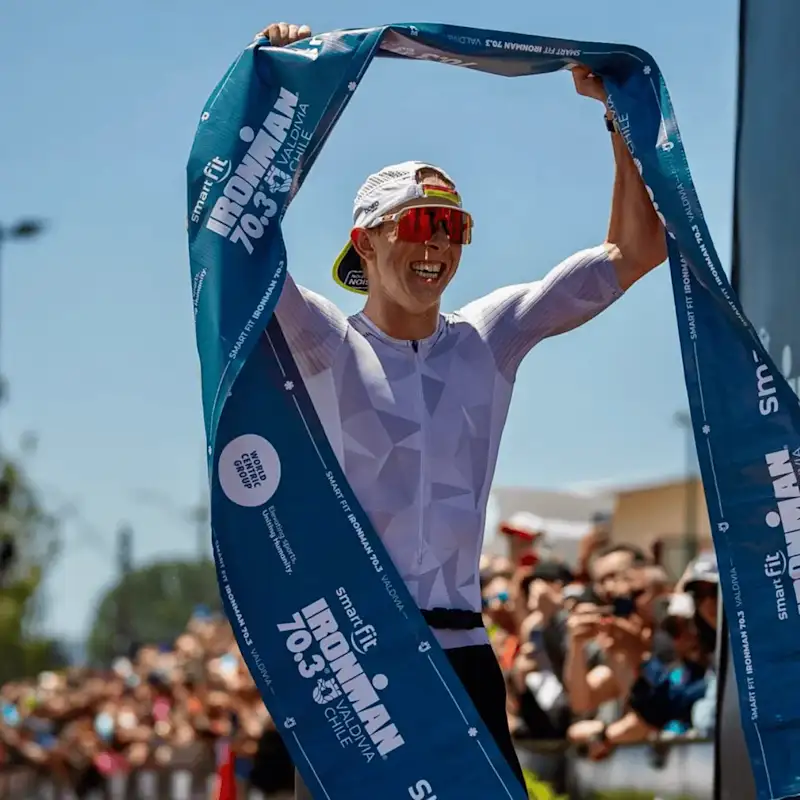
Colin Szuch
IRONMAN 70.3® Boulder
Colin's headline numbers
Colin's strategy
Fueling
Carbohydrate is the main fuel you burn when racing. Failing to fuel properly is a leading cause of underperformance in longer races.
Colin demonstrated impressive grit at IRONMAN 70.3® Boulder despite dropping a bottle containing 90g of carbohydrates early into the bike. Thankfully, he came well-prepared and had extra fuel (PF 30 Chews) on hand to still meet his energy demands.
On the other hand, he followed up his 80g/h bike intake with just ~18g of carbohydrate over the half-marathon, an 80% drop-off in hourly intake. While a decrease from bike to run is common (our middle distance case studies have an average of -36%), such a steep decline would’ve contributed to his fatigue in the final 5km. Fortunately, Colin had done enough earlier in the race to maintain his gap to third place. In future, including at least one to two PF 30 Gels on the run would ensure a more consistent carbohydrate intake to sustain his energy levels all the way to the line.
Hydration
Taking on board an appropriate amount of fluid and sodium is essential to maintaining blood volume and supporting the cardiovascular effort needed to perform on race day.
Whilst the absolute amount of sodium and fluid consumed per hour is important, it’s critical to consider these in relation to each other. This is known as 'relative sodium concentration' and it’s expressed in milligrams per litre (mg/L). How much sodium you’re taking in per litre of fluid is more important than the absolute amount taken in per hour.
Sweat sodium concentration (mg/L) is largely genetically determined and remains relatively stable. Knowing how salty your sweat is enables you to replace a good proportion of your sweat losses, which can range from 200-2,000mg/L.
Whilst Colin’s losses are on the moderate side, getting his hydration strategy right is still crucial when it’s hot and/or humid as his higher sweat rate in these conditions can result in significant net losses over the duration of a race.
Learn moreDropping his litre bottle early on the bike impacted his hydration strategy, but Colin was able to adapt quickly by picking up additional plain water at aid stations (~500ml), which he drank alongside two Electrolyte Capsules. These spare capsules helped maintain the relative sodium concentration he was aiming for (1000mg/L) alongside his two other 500ml bottles of PF Carb & Electrolyte Drink Mix on the bike. Then on the run, he switched back to Electrolyte Capsules and plain water for convenience. This strategy allowed him to stay on top of his fluid and sodium losses in the moderate-to-warm conditions, and avoid the performance decline associated with significant levels of dehydration.
Caffeine
Beyond the Three Levers of Performance (carb, sodium and fluid), caffeine is one of only a few substances that is proven to improve performance for most endurance athletes as it can help stave off mental and physical fatigue.
Having two PF 30 Caffeine Gels on race day put Colin’s total intake just below the lower end of caffeine recommendations for endurance performance. To better capitalise on the stimulant’s ergogenic effects, he could try including one (or two) more PF 30 Caffeine Gels, such as at the start of the run, to reach the evidence-backed dose.
How Colin hit his numbers
Here's everything that Colin ate and drank on the day...
Colin's weapons of choice
Final thoughts
Colin's full stats
Data Confidence?
There is good confidence in the accuracy of the data reported. An athlete feels that the numbers closely reflect what they consumed despite a couple of estimations which may carry some degree of error. The majority of what was consumed is recorded to a high level of specificity (most volumes are known through the use of bottles brands quantities flavours). The numbers are very plausible and align with previous data recordings (if an athlete has collected data previously).